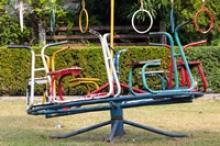
Playgrounds are intended to be fun, safe places to take children to visit and play. The National Playground Safety Institute (NPSI), a program developed under the National Recreation and Park Association (NRPA), identified twelve of the leading causes of injury on playgrounds known as “The Dirty Dozen.” These dangers include improper protective surfacing, inadequate use zones, and protrusion, entanglement, and entrapment hazards to name a few.1
Depending on the location of the playground, however, parents and caregivers need to be on the lookout for more than just “The Dirty Dozen.”2 There may be some additional hidden dangers on the playground.
Some of the additional dangers that may be lurking in the environment may be created by man or by nature. Alert caregivers need to be aware of their surroundings and be on guard for such things as:
- Blades
- Needles
- Guns and other weapons
- Animal feces
- Decaying garbage
- Arsenic in old wood equipment
- Sharp objects
- Lead in paint on older equipment
- Bees in playground equipment and in ground nests
- Poisonous plants
- Poisonous critters
Blades have been found on playgrounds. The incidents reported about blades lead one to assume that they were placed to deliberately injure children using the playground. In Langley, British Columbia, blades were discovered in the cracks of the rubber surface matting and buried in the sand at two different parks.3 In Pleasant Valley, New York, a razor blade was inserted into the bottom of a slide, so that the blade stuck up into the slide. The child that was injured on this slide needed 30 stitches to close the laceration caused by the blade.4
Needles are another danger that have been found on playgrounds. School campuses and playgrounds are accessible after hours and are used by persons who might bring drug paraphernalia onto the premises. If a child were to find a used hypodermic needle and be stuck by it, the child could contract a serious blood-borne disease, such as HIV or hepatitis B or C.
Guns and weapons are another danger that have been finding their way onto children’s playgrounds. Guns are lethal in the hands of children and criminals. The snipers in the Washington, DC area in 2002, left a letter at a shooting site that said “your children are not safe anywhere.” For days, children were kept off the playgrounds at schools and child care centers in this area.5
Disputes between young people are now likely to be settled by guns instead of fist fights.6 Since playgrounds are a gathering place for young people after school hours, reports of playground gun violence are familiar to people all across the country.
Other man-made dangers on the playground include decaying garbage, arsenic, lead paint, and sharp objects. Arsenic can be found in and around equipment made with pressure treated wood. If arsenic is suspected, the wood or soil can be tested by a local laboratory. Lead paint could still be found on older playground equipment. Sharp objects can be found almost anywhere. Play equipment should be checked before children are allowed to use it.
Nature-made dangers include animal feces, especially in sandboxes, bees, poisonous plants, and poisonous critters, such as spiders and snakes. Animal droppings can produce bacteria, which can infect children that come in contact with it. Open sand boxes without covers are the main place to look for this danger. Bees can be found living in holes in the play equipment or in ground nests.
In the northeast, as well as other parts of the country, it is a common thing to find poison ivy growing on fences around play areas or in trees adjacent to play areas. Poison oak and poison sumac should also be on a caregiver’s radar. In certain parts of the country, poisonous spiders or poisonous snakes are native to the area and may infiltrate children’s play environments.
Caregivers should know the areas where they wish to take children to play and be aware of the potential hazards. By being aware of these hidden dangers on the playground, the playground experience can be fun and safe.
- 1. The Dirty Dozen: Are they hiding in your child’s playground? Arlington, Virginia. National Recreation and Park Association.
- 2. Ibid.
- 3. “Blades found on playgrounds. Patrols of City parks stepped up after razor and knife blades found, child cut.” Langley Times. 26 Aug. 2007. < http://www.langleytimes.com > 27 Aug. 2007.
- 4. “Child charged in slide tampering.” WABC Eyewitness News. 9 Apr. 2009. < http://abclocal.go.com/wabc/story?section=news/local&id=6753265 > 10 Apr. 2009.
- 5. McKain, Gini and Dan. “ʽNot Safe Anywhere’…?” Today’s Playground. January 2003. pp. 30-32.
- 6. “Juvenile Justice. Kids and Guns: From Playgrounds to Battlefields.” U.S. Department of Justice, Journal of the Office of Juvenile Justice and Delinquency Prevention, Volume III, Number 2, September 1997. pp. 3-10.

